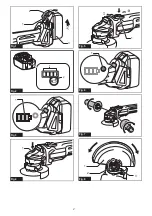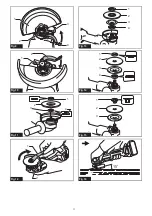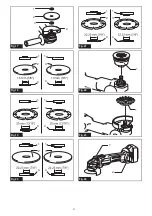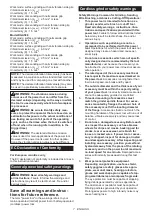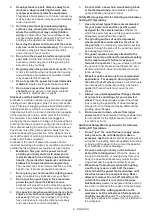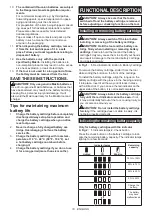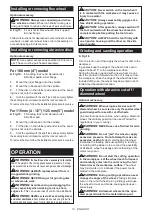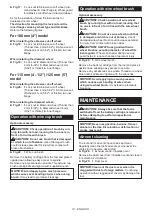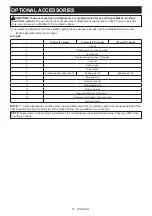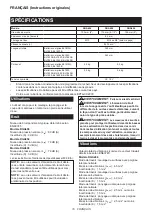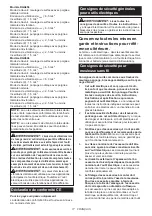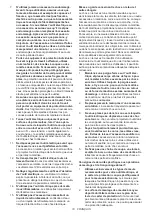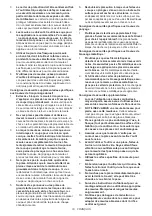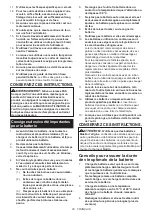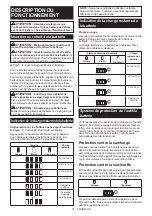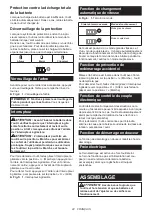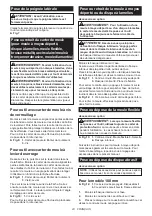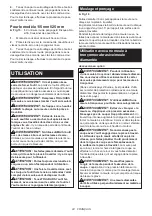
9 ENGLISH
5.
Support panels or any oversized workpiece to
minimize the risk of wheel pinching and kick-
back.
Large workpieces tend to sag under their
own weight. Supports must be placed under the
workpiece near the line of cut and near the edge
of the workpiece on both sides of the wheel.
6.
Use extra caution when making a “pocket cut”
into existing walls or other blind areas.
The
protruding wheel may cut gas or water pipes, elec
-
trical wiring or objects that can cause kickback.
Safety Warnings Specific for Sanding Operations:
1.
Do not use excessively oversized sanding
disc paper. Follow manufacturers recommen-
dations, when selecting sanding paper.
Larger
sanding paper extending beyond the sanding
pad presents a laceration hazard and may cause
snagging, tearing of the disc or kickback.
Safety Warnings Specific for Wire Brushing
Operations:
1.
Be aware that wire bristles are thrown by the
brush even during ordinary operation. Do not
overstress the wires by applying excessive
load to the brush.
The wire bristles can easily
penetrate light clothing and/or skin.
2.
If the use of a guard is recommended for wire
brushing, do not allow any interference of the
wire wheel or brush with the guard.
Wire wheel
or brush may expand in diameter due to work load
and centrifugal forces.
Additional Safety Warnings:
1.
When using depressed centre grinding wheels,
be sure to use only fiberglass-reinforced
wheels.
2.
NEVER USE Stone Cup type wheels with this
grinder.
This grinder is not designed for these
types of wheels and the use of such a product
may result in serious personal injury.
3.
Be careful not to damage the spindle, the
flange (especially the installing surface) or the
lock nut. Damage to these parts could result in
wheel breakage.
4.
Make sure the wheel is not contacting the
workpiece before the switch is turned on.
5.
Before using the tool on an actual workpiece,
let it run for a while. Watch for vibration or
wobbling that could indicate poor installation
or a poorly balanced wheel.
6.
Use the specified surface of the wheel to per
-
form the grinding.
7.
Do not leave the tool running. Operate the tool
only when hand-held.
8.
Do not touch the workpiece immediately after
operation; it may be extremely hot and could
burn your skin.
9.
Observe the instructions of the manufacturer
for correct mounting and use of wheels.
Handle and store wheels with care.
10.
Do not use separate reducing bushings or
adaptors to adapt large hole abrasive wheels.
11.
Use only flanges specified for this tool.
12.
For tools intended to be fitted with threaded
hole wheel, ensure that the thread in the wheel
is long enough to accept the spindle length.
13.
Check that the workpiece is properly
supported.
14.
Pay attention that the wheel continues to
rotate after the tool is switched off.
15.
If working place is extremely hot and humid,
or badly polluted by conductive dust, use a
short-circuit breaker (30 mA) to assure opera-
tor safety.
16.
Do not use the tool on any materials contain-
ing asbestos.
17.
When use cut-off wheel, always work with
the dust collecting wheel guard required by
domestic regulation.
18.
Cutting discs must not be subjected to any
lateral pressure.
19.
Do not use cloth work gloves during operation.
Fibers from cloth gloves may enter the tool, which
causes tool breakage.
SAVE THESE INSTRUCTIONS.
WARNING:
DO NOT let comfort or familiarity
with product (gained from repeated use) replace
strict adherence to safety rules for the subject
product. MISUSE or failure to follow the safety
rules stated in this instruction manual may cause
serious personal injury.
Important safety instructions for
battery cartridge
1.
Before using battery cartridge, read all instruc-
tions and cautionary markings on (1) battery
charger, (2) battery, and (3) product using
battery.
2.
Do not disassemble battery cartridge.
3.
If operating time has become excessively
shorter, stop operating immediately. It may
result in a risk of overheating, possible burns
and even an explosion.
4.
If electrolyte gets into your eyes, rinse them
out with clear water and seek medical atten-
tion right away. It may result in loss of your
eyesight.
5.
Do not short the battery cartridge:
(1)
Do not touch the terminals with any con-
ductive material.
(2)
Avoid storing battery cartridge in a con-
tainer with other metal objects such as
nails, coins, etc.
(3)
Do not expose battery cartridge to water
or rain.
A battery short can cause a large current
flow, overheating, possible burns and even a
breakdown.
6.
Do not store the tool and battery cartridge in
locations where the temperature may reach or
exceed 50 °C (122 °F).
7.
Do not incinerate the battery cartridge even if
it is severely damaged or is completely worn
out. The battery cartridge can explode in a fire.
8.
Be careful not to drop or strike battery.
9.
Do not use a damaged battery.


